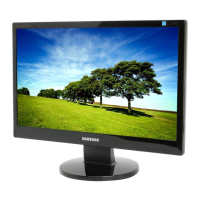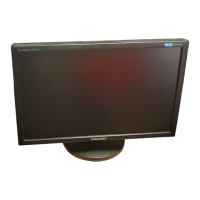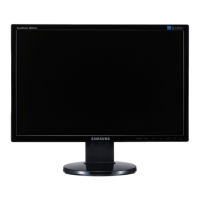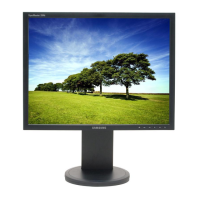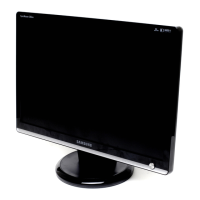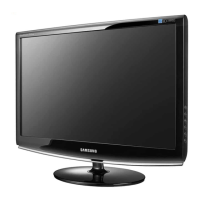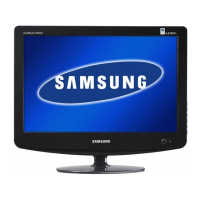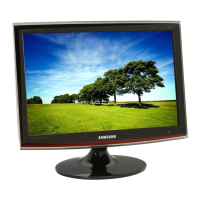Do you have a question about the Samsung SyncMaster 2043SN and is the answer not in the manual?
Explains the use of notes and important information for safety.
Highlights potential dangers and warnings to prevent injury or damage.
Defines symbols and their meanings for safety instructions.
Instructions and warnings related to the power supply and usage.
Guidelines and precautions for installing the monitor safely.
Instructions for cleaning the monitor safely and effectively.
Additional safety precautions and guidelines for various situations.
Factors affecting monitor quality related to its surroundings.
General advice for optimizing monitor performance and troubleshooting.
How to determine if the monitor is functioning correctly.
A list of checks to perform before seeking assistance.
Steps to diagnose and resolve issues with no display or power.
Troubleshooting steps for color display issues or monochrome output.
Solutions for screen unbalancing or image distortion.
Steps to fix focus issues or problems with the On-Screen Display.
Diagnosing issues when the LED blinks but no image appears.
Lists all items included in the monitor package.
Visual guide to the different monitor stand types.
Description of the monitor with a simple stand.
Description of the monitor with a HAS stand.
Lists the included manuals and documentation.
Identifies various cables included with the monitor.
Details about the monitor's features and design.
Steps for initial setup and language selection.
Overview of the monitor's front panel controls and indicators.
Function of the MENU button for OSD navigation.
How to customize button assignments for user preferences.
Explanation of buttons used for menu item adjustments.
How to adjust brightness directly using a dedicated button.
Functionality of the button for selecting video signals.
How to activate highlighted menu items.
Use of the AUTO button for automatic picture adjustment.
Function of the power button for turning the monitor on/off.
Explanation of the power indicator light status.
How to adjust volume using the monitor controls.
Location and function of the headphone jack.
Information about audio output and speaker functionality.
Description of the monitor's rear panel connections.
Location and function of the power connection port.
Instructions for connecting to the DVI input.
Instructions for connecting to the RGB input.
Information about the optional USB connection port.
Explanation of the Kensington lock feature for security.
Step-by-step guide on how to use the Kensington lock.
Guidance on connecting various cables for monitor setup.
How to connect the monitor using a D-sub (Analog) cable.
How to connect the monitor using a DVI (Digital) cable.
Instructions for connecting the power cord.
Information on connecting USB devices to the monitor.
How to connect the upstream USB port.
How to connect downstream USB ports to devices.
Details on connecting audio input devices.
Instructions for installing the monitor driver software.
Step-by-step guide for automatic driver installation.
Manual installation steps for the monitor driver.
Process for updating the driver through the device manager.
Steps to manually locate and install driver software.
How to install drivers from a disk or specific folder.
Choosing the correct monitor model from a list for driver installation.
Specific driver installation steps for Windows XP.
Driver installation procedures for Windows 2000.
General manual installation steps for drivers.
Steps for manual driver installation on Windows NT.
Confirmation of successful driver installation.
Driver installation for Windows Millennium Edition.
Introduction to Samsung's Natural Color software for color accuracy.
Information about MagicTune software for monitor settings.
Step-by-step instructions for installing MagicTune software.
Potential issues during MagicTune installation and troubleshooting.
OS and hardware requirements for MagicTune software.
Procedures for removing MagicTune software.
Details on the MagicRotation software for screen orientation.
Steps to install the MagicRotation software.
Troubleshooting common installation issues for MagicRotation.
OS and hardware requirements for MagicRotation software.
Recommendations for system service packs.
Instructions on how to uninstall MagicRotation software.
Information about the MultiScreen software.
Steps to install the MultiScreen software.
Explains direct control functions for monitor adjustment.
How to use the AUTO button for automatic picture adjustment.
Functionality for locking and unlocking the On-Screen Display.
How to customize key assignments for user preferences.
How to adjust the monitor's brightness settings.
Selecting the video signal source for the monitor.
Overview of the On-Screen Display functions and menus.
Adjustments for picture settings like brightness and contrast.
Settings related to color balance, effect, and tone.
Adjusting the screen size and position.
Adjusting the horizontal position of the display.
Adjusting the vertical position of the display.
Changing the displayed screen size for PC and AV signals.
Adjusting the horizontal position of the OSD menu.
Options for resetting settings and adjusting display transparency.
Restores product settings to factory defaults.
Controls the transparency of the OSD menu background.
Selects the display language for menus.
Enables or disables the Off Timer function.
Sets the automatic monitor turn-off time.
Automatically selects the signal source.
General specifications including model name, size, and display area.
Horizontal and vertical synchronization specifications.
Optimal and maximum display resolutions.
Details on supported input signals.
The maximum pixel clock frequency supported.
Specifications for the monitor's power supply.
Information about the included signal cable.
Physical dimensions and weight without the stand.
Physical dimensions and weight with the HAS stand.
Specifications for VESA mounting compatibility.
Operating and storage environmental requirements.
Information on the monitor's Plug & Play compatibility.
Explanation of acceptable pixel variations.
Explanation of the monitor's power saving system.
Table detailing power states and consumption.
Definition and unit of horizontal scanning frequency.
Definition and unit of vertical scanning frequency.
Tips for optimizing computer resolution and screen settings for best picture quality.
Guidance on correct usage to protect LCD products from image retention.
Details on what the warranty covers and does not cover regarding image retention.
Explanation of the phenomenon of image retention in LCD panels.
Examples of suggested display patterns and color changes to prevent retention.
Recommendations for specific use cases like airports and stock markets.
Further examples of character display changes to prevent image retention.
Diagram illustrating pixel fault class and structure of LCD panels.
Contact information and websites for Samsung customer care worldwide.
Definitions of technical terms like Dot Pitch, Vertical Frequency, and Horizontal Frequency.
Guidelines for the proper disposal of electronic waste according to regulations.
Information regarding copyright, liability, and trademark notices.
Explains the use of notes and important information for safety.
Highlights potential dangers and warnings to prevent injury or damage.
Defines symbols and their meanings for safety instructions.
Instructions and warnings related to the power supply and usage.
Guidelines and precautions for installing the monitor safely.
Instructions for cleaning the monitor safely and effectively.
Additional safety precautions and guidelines for various situations.
Factors affecting monitor quality related to its surroundings.
General advice for optimizing monitor performance and troubleshooting.
How to determine if the monitor is functioning correctly.
A list of checks to perform before seeking assistance.
Steps to diagnose and resolve issues with no display or power.
Troubleshooting steps for color display issues or monochrome output.
Solutions for screen unbalancing or image distortion.
Steps to fix focus issues or problems with the On-Screen Display.
Diagnosing issues when the LED blinks but no image appears.
Lists all items included in the monitor package.
Visual guide to the different monitor stand types.
Description of the monitor with a simple stand.
Description of the monitor with a HAS stand.
Lists the included manuals and documentation.
Identifies various cables included with the monitor.
Details about the monitor's features and design.
Steps for initial setup and language selection.
Overview of the monitor's front panel controls and indicators.
Function of the MENU button for OSD navigation.
How to customize button assignments for user preferences.
Explanation of buttons used for menu item adjustments.
How to adjust brightness directly using a dedicated button.
Functionality of the button for selecting video signals.
How to activate highlighted menu items.
Use of the AUTO button for automatic picture adjustment.
Function of the power button for turning the monitor on/off.
Explanation of the power indicator light status.
How to adjust volume using the monitor controls.
Location and function of the headphone jack.
Information about audio output and speaker functionality.
Description of the monitor's rear panel connections.
Location and function of the power connection port.
Instructions for connecting to the DVI input.
Instructions for connecting to the RGB input.
Information about the optional USB connection port.
Explanation of the Kensington lock feature for security.
Step-by-step guide on how to use the Kensington lock.
Guidance on connecting various cables for monitor setup.
How to connect the monitor using a D-sub (Analog) cable.
How to connect the monitor using a DVI (Digital) cable.
Instructions for connecting the power cord.
Information on connecting USB devices to the monitor.
How to connect the upstream USB port.
How to connect downstream USB ports to devices.
Details on connecting audio input devices.
Instructions for installing the monitor driver software.
Step-by-step guide for automatic driver installation.
Manual installation steps for the monitor driver.
Process for updating the driver through the device manager.
Steps to manually locate and install driver software.
How to install drivers from a disk or specific folder.
Choosing the correct monitor model from a list for driver installation.
Specific driver installation steps for Windows XP.
Driver installation procedures for Windows 2000.
General manual installation steps for drivers.
Steps for manual driver installation on Windows NT.
Confirmation of successful driver installation.
Driver installation for Windows Millennium Edition.
Introduction to Samsung's Natural Color software for color accuracy.
Information about MagicTune software for monitor settings.
Step-by-step instructions for installing MagicTune software.
Potential issues during MagicTune installation and troubleshooting.
OS and hardware requirements for MagicTune software.
Procedures for removing MagicTune software.
Details on the MagicRotation software for screen orientation.
Steps to install the MagicRotation software.
Troubleshooting common installation issues for MagicRotation.
OS and hardware requirements for MagicRotation software.
Recommendations for system service packs.
Instructions on how to uninstall MagicRotation software.
Information about the MultiScreen software.
Steps to install the MultiScreen software.
Explains direct control functions for monitor adjustment.
How to use the AUTO button for automatic picture adjustment.
Functionality for locking and unlocking the On-Screen Display.
How to customize key assignments for user preferences.
How to adjust the monitor's brightness settings.
Selecting the video signal source for the monitor.
Overview of the On-Screen Display functions and menus.
Adjustments for picture settings like brightness and contrast.
Settings related to color balance, effect, and tone.
Adjusting the screen size and position.
Adjusting the horizontal position of the display.
Adjusting the vertical position of the display.
Changing the displayed screen size for PC and AV signals.
Adjusting the horizontal position of the OSD menu.
Options for resetting settings and adjusting display transparency.
Restores product settings to factory defaults.
Controls the transparency of the OSD menu background.
Selects the display language for menus.
Enables or disables the Off Timer function.
Sets the automatic monitor turn-off time.
Automatically selects the signal source.
General specifications including model name, size, and display area.
Horizontal and vertical synchronization specifications.
Optimal and maximum display resolutions.
Details on supported input signals.
The maximum pixel clock frequency supported.
Specifications for the monitor's power supply.
Information about the included signal cable.
Physical dimensions and weight without the stand.
Physical dimensions and weight with the HAS stand.
Specifications for VESA mounting compatibility.
Operating and storage environmental requirements.
Information on the monitor's Plug & Play compatibility.
Explanation of acceptable pixel variations.
Explanation of the monitor's power saving system.
Table detailing power states and consumption.
Definition and unit of horizontal scanning frequency.
Definition and unit of vertical scanning frequency.
Tips for optimizing computer resolution and screen settings for best picture quality.
Guidance on correct usage to protect LCD products from image retention.
Details on what the warranty covers and does not cover regarding image retention.
Explanation of the phenomenon of image retention in LCD panels.
Examples of suggested display patterns and color changes to prevent retention.
Recommendations for specific use cases like airports and stock markets.
Further examples of character display changes to prevent image retention.
Diagram illustrating pixel fault class and structure of LCD panels.
Contact information and websites for Samsung customer care worldwide.
Definitions of technical terms like Dot Pitch, Vertical Frequency, and Horizontal Frequency.
Guidelines for the proper disposal of electronic waste according to regulations.
Information regarding copyright, liability, and trademark notices.
| Pixel pitch | 0.2768 x 0.2768 mm |
|---|---|
| Aspect ratio | 16:9 |
| Display diagonal | 20 \ |
| Separate H/V sync | Yes |
| Display resolution | 1600 x 900 pixels |
| Vertical scan range | 50 - 75 Hz |
| Horizontal scan range | 31 - 80 kHz |
| Viewing angle, vertical | 160 ° |
| Contrast ratio (dynamic) | 15000:1 |
| Viewing angle, horizontal | 170 ° |
| Display brightness (typical) | 250 cd/m² |
| Special features | MagicBright3, Color Effect, MagicWizard S/W, MagicTune S/W, Windows Vista Basic, Multiscreen S/W |
| Power requirements | Internal |
| Panel mounting interface | 75 x 75 mm |
| Power consumption (standby) | 1 W |
| Power consumption (typical) | 25 W |
| Market positioning | - |
| Depth (with stand) | 217.5 mm |
|---|---|
| Height (with stand) | 392.4 mm |
| Depth (without stand) | 71.3 mm |
| Width (without stand) | 479 mm |
| Height (without stand) | 306 mm |
| Weight (without stand) | 4500 g |
